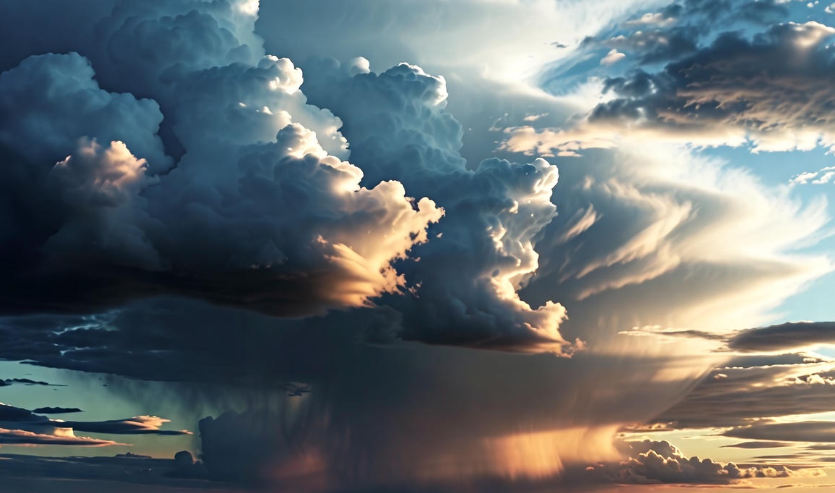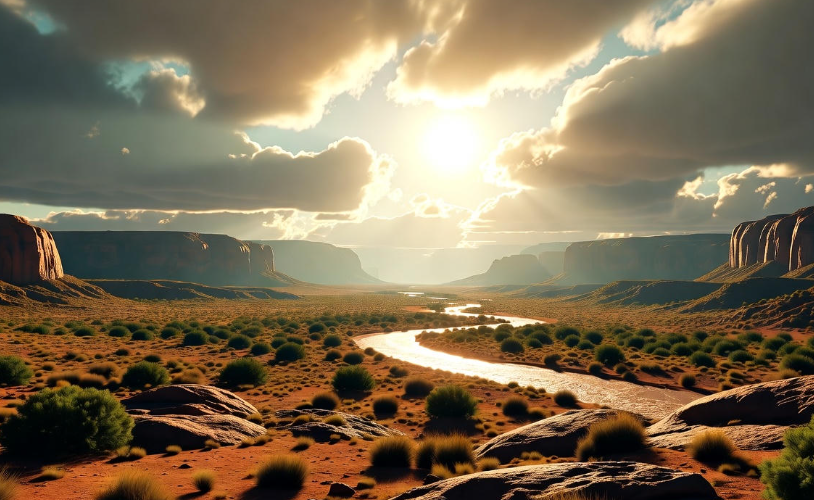When you think about human evolution, you might imagine fossils, ancient tools, or DNA changes. But behind all of that, there’s something even more powerful — climate. Yes, the air we breathe, the weather we live in, and the environment that surrounds us have been quietly guiding human evolution for millions of years. Our ancestors didn’t just evolve by chance — they adapted to survive constant climate changes that shaped their bodies, minds, and behaviors.
Let’s explore how this invisible force — the climate — played a major role in making us who we are today.
The Earth That Kept Changing 🌦️
Millions of years ago, the Earth wasn’t as stable as it seems today. The continents were shifting, oceans were forming, and global temperatures were swinging between hot and cold phases. These changes were not just background events — they decided where plants grew, where animals lived, and most importantly, where early humans could survive.
When Africa — known as the “cradle of humanity” — started drying up about 7 million years ago, thick forests slowly turned into open grasslands. This single transformation forced our ape-like ancestors to leave the trees and start walking on the ground. And that’s when one of the biggest evolutionary leaps happened — bipedalism, or walking on two legs.
It wasn’t comfort that made our ancestors stand tall; it was survival. When forests vanished, standing upright helped them look over tall grass for predators, travel longer distances under the sun, and free their hands to carry food or tools.
| Climate Shift | Human Adaptation |
|---|---|
| Forests turned into grasslands | Walking on two legs (bipedalism) |
| Temperature dropped | Hair loss, sweat glands evolved for cooling |
| Less rainfall | Migration to water-rich areas |
| Seasonal food changes | Development of tool use for hunting/gathering |
The Role of Ice Ages ❄️
Fast forward a few million years — Earth entered a cycle of ice ages. These cold and harsh periods tested human endurance. Every time glaciers advanced, habitats changed. Forests vanished, deserts expanded, and animals migrated. Humans had two choices: adapt or die out.
During these times, brain evolution accelerated. Surviving unpredictable weather meant learning how to make fire, store food, build shelters, and create clothing. The brain became the most valuable survival tool. Interestingly, fossil records show that as the climate became more unstable, human brains grew larger and more complex.
This shows that climate didn’t just shape our bodies; it shaped our intelligence. Adapting to cold, heat, drought, and famine forced us to plan, cooperate, and invent.
Africa: The Climate Laboratory of Evolution 🌍
Africa experienced intense and repeated climate swings — sometimes wet and full of lakes, other times dry and barren. These fluctuations created what scientists call a “climate pump,” pushing early humans to evolve rapidly.
For example, when droughts hit East Africa, populations became isolated in small areas with limited resources. Isolation led to genetic diversity — small groups evolved differently based on local conditions. That’s why multiple human species (like Homo habilis, Homo erectus, and later Homo sapiens) appeared in overlapping timelines.
When the climate improved, these groups spread out again, mixing and competing. Evolution wasn’t a straight line — it was a series of climate-driven experiments.
The Power of Migration 🚶♂️🌏
Climate didn’t just change how humans lived — it moved them. Every major wave of human migration was triggered by climate shifts.
When glaciers retreated, fertile lands opened up. When deserts expanded, people moved toward rivers and coasts. Around 70,000 years ago, a major drought in Africa likely forced Homo sapiens to migrate out of the continent. This journey led humans to Asia, Europe, and eventually every corner of the Earth.
As they spread, humans encountered drastically different climates. Those in colder regions developed lighter skin to absorb more sunlight. Those near the equator evolved darker skin to protect from UV radiation. Over thousands of years, these adaptations gave rise to the diversity we see in humanity today.
| Region | Climate | Adaptation |
|---|---|---|
| Africa | Hot and sunny | Darker skin, sweat glands |
| Europe | Cold and cloudy | Lighter skin for Vitamin D absorption |
| Asia | Varied climates | Eye shape and nasal structure changes |
| Arctic | Freezing | Stockier bodies to conserve heat |
The Agricultural Revolution and Stable Climate 🌾
One of the most remarkable things about human history is that civilization didn’t begin during chaos — it began during stability.
Around 10,000 years ago, the Earth entered a relatively stable climate period called the Holocene. For the first time in thousands of years, weather patterns became predictable. This allowed humans to stop wandering and start farming.
Stable rainfall and temperature encouraged crop growth. With food security, humans built villages, then cities, then nations. This marked the birth of civilization. Without this climate calm, agriculture might never have started — and neither would modern society.
How Climate Still Shapes Us Today 🌡️
Even though we live in concrete cities now, climate is still shaping our behavior, culture, and even health. Regions with hotter climates often develop slower lifestyles and lighter clothing traditions. Cold regions encourage resource storage, energy-efficient homes, and strong community ties.
But modern climate change is moving faster than ever before. Rising sea levels, extreme heat, and unpredictable weather could trigger new migrations and force human adaptation once again. Some scientists believe the future of evolution will be technological adaptation — using innovation to survive instead of biological change.
| Past Evolution | Modern Adaptation |
|---|---|
| Natural selection | Technological innovation |
| Migration due to droughts | Climate refugees & urban shifts |
| Evolution of physical traits | Evolution of digital and mental resilience |
Small Climate Changes, Big Human Shifts 🌬️
Even tiny temperature or rainfall shifts changed the way humans lived. For instance:
-
When rainfall decreased, early humans developed tools to dig roots and hunt tougher animals.
-
When temperatures dropped, clothing and shelter became essential inventions.
-
When food was scarce, cooperation and sharing increased within tribes — giving rise to social behavior.
-
When sunlight changed, body pigmentation adapted for survival.
Each climate challenge forced creativity, cooperation, and innovation — traits that make humans unique.
Why Understanding Climate and Evolution Matters Today 🌏
Knowing how climate shaped human evolution isn’t just about the past — it’s about our future. If we understand how adaptable our ancestors were, we can learn how to handle modern climate problems with the same resilience.
It reminds us that humans are not separate from nature; we are a product of it. The weather that once molded our bones now demands we use our minds to protect our planet.
Quick Recap Table 🧠
| Key Climate Event | Result on Human Evolution |
|---|---|
| African drying (7M years ago) | Bipedalism, tool use |
| Ice Ages | Brain growth, intelligence, social bonding |
| African drought (70K years ago) | Migration out of Africa |
| Holocene stability (10K years ago) | Agriculture and civilization |
| Modern warming | Technological adaptation, global migration |

Interesting Fact 🤔
Scientists have found that human DNA actually contains clues about ancient climate events. Genetic mutations often line up with major environmental changes — proving that when the Earth shifts, we shift with it.
A Human Story Written by the Weather
From walking on two feet to building cities, the story of humans is deeply tied to the story of the Earth. Climate didn’t just influence where we lived; it influenced who we became. Every skill we have today — thinking ahead, solving problems, cooperating — was born from the challenge of surviving nature’s unpredictable moods.
So, the next time you feel the sun on your skin or the wind against your face, remember — it’s not just weather. It’s a silent storyteller of our past, a teacher of adaptation, and perhaps, the guide to our future. 🌤️
FAQs 🧩
Q1: How exactly did climate make humans walk on two legs?
Because forests disappeared and open grasslands took over, our ancestors had to travel longer distances for food. Walking on two legs was energy-efficient and helped them see predators above tall grass.
Q2: Did humans evolve only in Africa?
Most scientists agree that modern humans (Homo sapiens) originated in Africa, but other species of early humans evolved in Asia and Europe too. Climate-driven migration spread these groups worldwide.
Q3: How did the Ice Age help human intelligence grow?
The Ice Age forced early humans to invent clothing, fire, and tools for survival. These constant challenges made problem-solving and planning vital — driving brain evolution.
Q4: Can modern climate change cause new human evolution?
Possibly, but not in the same way. Biological evolution takes thousands of years. Today, humans adapt faster through technology — air conditioning, medicine, and innovation.
Q5: What was the most important climate period for civilization?
The Holocene, starting about 10,000 years ago. Its stable weather allowed agriculture to thrive, leading to cities, writing, and modern society.
If we look back carefully, we’ll see that climate was the real sculptor of humanity — sometimes harsh, sometimes kind, but always powerful. And as the climate continues to change, our story as a species is still being written. 🌍✨

Leave a Reply